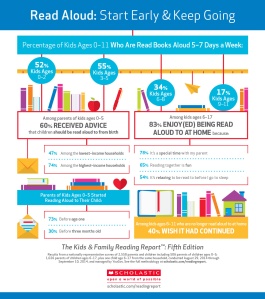Scholastic published a new report this month focusing on the reading habits of children and their families. This is the fifth edition of the report, which included over 2,500 children and their parents. It’s one of the more fascinating things I’ve read lately, both for the points it raises that were surprising, and the fond memories I have of childhood reading.
Lisa Guernsey at the New America Foundation has a great rundown of the survey itself and of some of the more interesting findings:
The results are packed with interesting nuggets for parents and educators alike. They show a decline in “reading for fun” at home among some age groups…while they also show the importance of school to low-income children as a place for reading. A new section of the report provides insight into reading habits among parents of infants, toddlers, and preschoolers. And many of the children’s responses throughout the report point to the power of allowing children to choose what to read.
Scholastic has published a few great graphics on the findings of the report, including what kids are looking for in books (52%…say the person who does the best job of picking out books to read for fun is ‘Me.'”) and how tastes change by age. The report includes finding on the frequency of parents reading to children, a measure that has become increasingly discussed with the recent American Academy of Pediatrics recommendation for children to be read to from birth. While parents recognized the importance of reading aloud to children who were learning to read (though they often were not able to do this as much as they would like), a particularly fascinating finding was about reading to children after they are able to read on their own. From the NIEER online newsletter, which I co-write:
The study found that while more than half of children ages 0 to 5 were read to between 5-7 days each week, about one-third of children age 6-8 were read to, and only 17 percent of children ages 9 to 11 had this experience. Eighty-three percent of children ages 6-17 reported they “enjoy(ed) being read aloud to at home,” saying it was a special and fun experience with parents. Additionally, according to a piece in The New York Times, “…literacy experts say the real value of reading to children is helping to develop background knowledge in all kinds of topics as well as exposure to sophisticated language.”
Kids want to be read to. Even kids who may claim to be “too old” or “too cool” for Mom or Dad to sit down with a book may occasionally like the experience! And here’s why:

I have such wonderful memories of being read to. I agree with that 78% who say it creates a special time with parents, but as a kid myself, I go to be on the flipside. My “little brother” (read: now in his second year of teaching high school) wasn’t the strongest reader as a kid, and it kept him from being the kind of voracious reader I was. As I was tearing through the Harry Potter books, he wasn’t sure he wanted to dive into them. So I read them to him, out loud. From across the bedroom we shared. In the backseat of the car in 20 minute chunks as my mom drove out to my older brother’s high school with us in tow. For 15 minutes sitting out adult swim at the pool. When the fourth book came out, I read it for the first time while reading it to him. When the fifth book came out, he felt up to taking it on by himself, and while that was great (except for fighting over our one copy!), there was a piece of the experience now gone for me. Whether it was just the pride of being the helpful big sister or really getting to share something I loved, I treasured those moments. I’m thinking of so many parent friends who post Facebook updates of their excitement to start reading Lord of the Rings to their kids – kids who wouldn’t be ready to take on those tomes yet, but get to experience this wonderful stories complete with a reader who will do different voices, share that experience, and hopefully remember it fondly when they pick them up again on their own years later.
You might not have time to read the whole report, but do try to find the time to grab your favorite childhood book – or help a young reader find a new favorite! – and settle in with the child in your life for some quality time.

